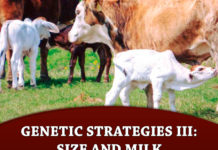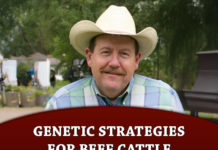Written by Buck Wehrbein, NCBA President
This year, NCBA has talked a lot about the threat of New World screwworm (NWS). We were the first national organization involved when screwworm was moving through Central America, and we raised alarm bells when it appeared in Mexico at the end of last year. In July, the U.S. Department of Agriculture (USDA) detected screwworm north of Veracruz, Mexico — about 370 miles from the U.S. border. NCBA and our state affi liate partners have been continuously working to combat the threat of New World screwworm, and we are focusing on a broad strategy to eradicate the pest and protect cattle health that involves everyone from the individual farm or ranch up to our international partners.
Our first priority is increasing sterile fly production. New World screwworm flies only mate once, so we can release sterile male flies into the environment to mate with female flies and ensure no off spring. In time, this eradicates the screwworm population. Right now, the COPEG sterile fly facility in Panama is producing about 100-117 million flies per week, but we need closer to 400-500 million flies per week to fully cover the current outbreak.
During the height of screwworm eradication efforts in the 1960s, the U.S. was releasing up to 500-600 million sterile flies per week. In mid-August, the USDA announced a major step in addressing NCBA’s top priority for combating New World screwworm: the construction of sterile fly production and distribution facilities at Moore Air Base in South Texas.
This initiative will increase weekly output to more than 300 million flies, strengthen domestic oversight and address supply challenges in Mexico and Central America — protecting cattle herds across borders. Another focus for NCBA is readiness for a possible incursion of screwworm into the U.S. NCBA is seeking coordination between state animal health officials.
In any animal health emergency, USDA may defer to state veterinarians and state ag commissioners who make decisions on the ground for their state based on perceived risks. If New World screwworm is detected anywhere in the U.S., state animal health offi cials need to be communicating and working with one another on establishing interstate animal movement controls.
They should be implementing science-based rules and inspections that keep cattle safe, while also ensuring commerce can continue. By establishing these relationships early, we can make sure state animal health officials and USDA understand what steps to take in case an outbreak appears in our country. Currently in the U.S., no FDA-approved medications are labeled to treat or prevent New World screwworm myiasis in cattle. Right now, if you were to experience an outbreak in your cattle, treatment may rely on extra-label use of approved drugs under veterinary guidance.
A recent U.S. Department of Health and Human Services declaration now allows the FDA to issue Emergency Use Authorizations for animal drugs targeting NWS infestations. Bottom line: This gives FDA greater flexibility to quickly update labels for approved products and evaluate unapproved ones. NCBA is continuing to push FDA’s Center for Veterinary Medicine to expedite the review of new animal drugs that could treat cattle suffering from screwworm infestation.
In the meantime, I strongly encourage you to maintain a relationship with a veterinarian, to alert your veterinarian of any health issues in your cattle herd, and to make sure you have an enhanced biosecurity plan in place as a precautionary measure. Finally, we are working with USDA to make sure Mexico is an active partner in the fight against screwworm.
Screwworm is endemic in many South American countries, which means there is always the threat of screwworm moving north. We have spent many hours with Mexican government officials and representatives of their cattle industry to make sure Mexico steps up their screwworm eradication efforts by establishing active surveillance with fly traps, supporting sterile fly release to control screwworm populations and initiating construction on a sterile fly production facility in Mexico as well as instituting movement controls and rigorous inspection and standardized treatments for cattle at their borders.
NCBA is doing everything we can to prevent an outbreak in the U.S. We will keep pushing to get more sterile flies, get approvals for new screwworm treatments, and hold Mexico accountable to fight against screwworm too. Th is is a rapidly changing situation, so for the latest updates be sure to follow NCBA on social media and visit our website at ncba.org.
Until next time, happy trails!























